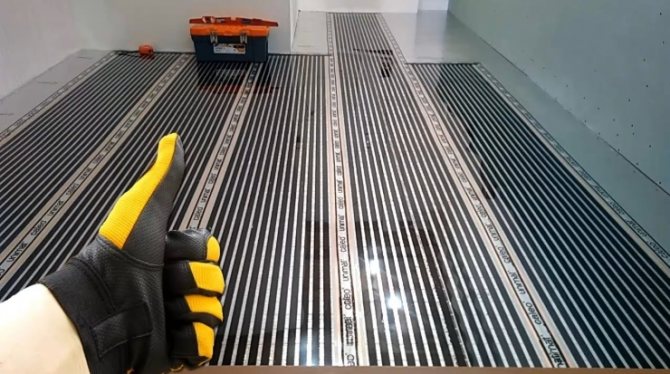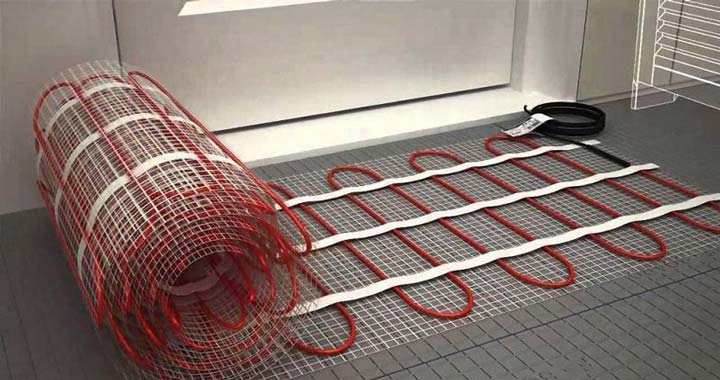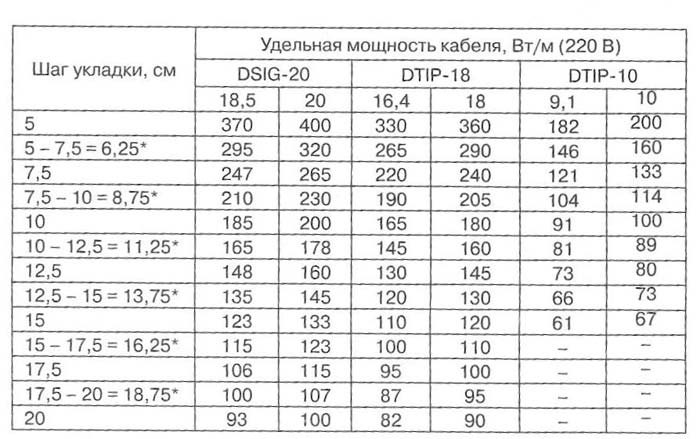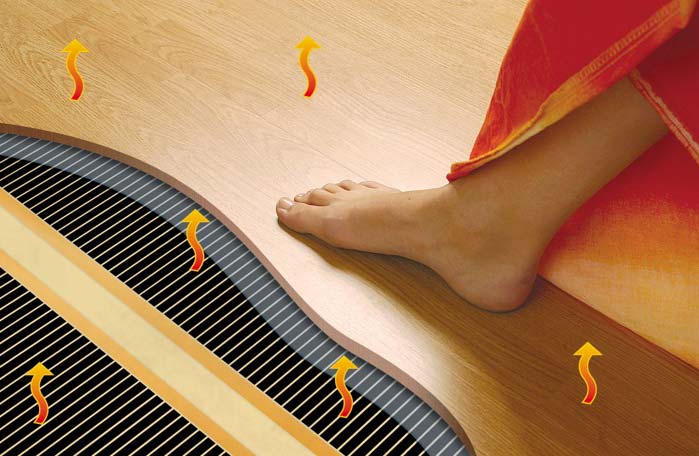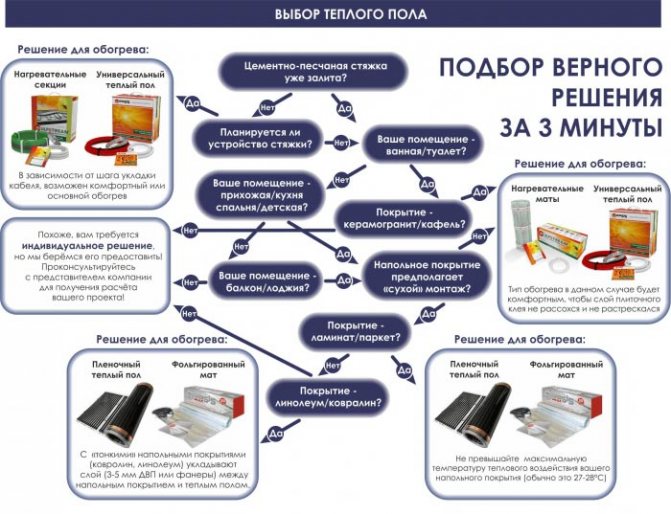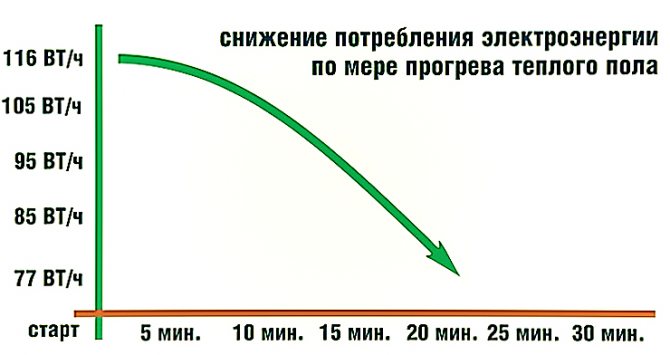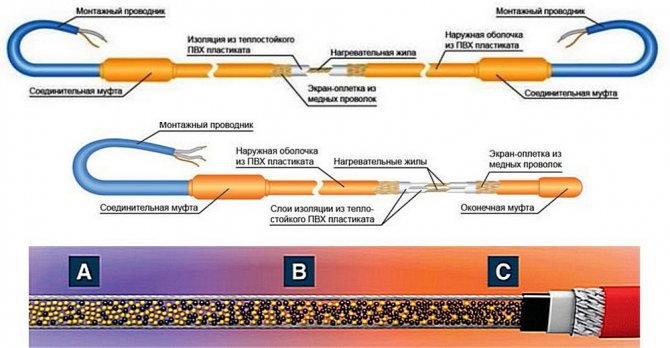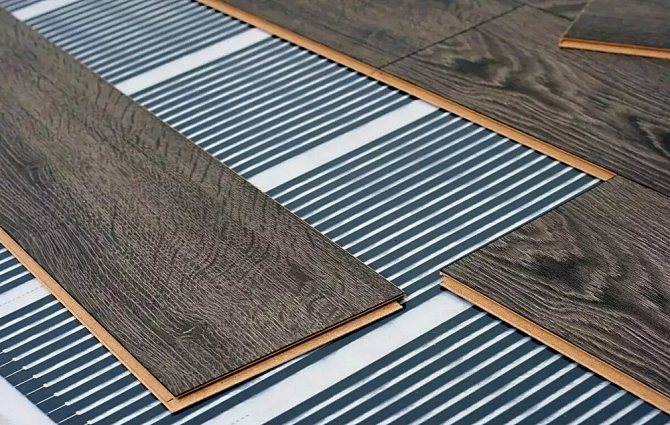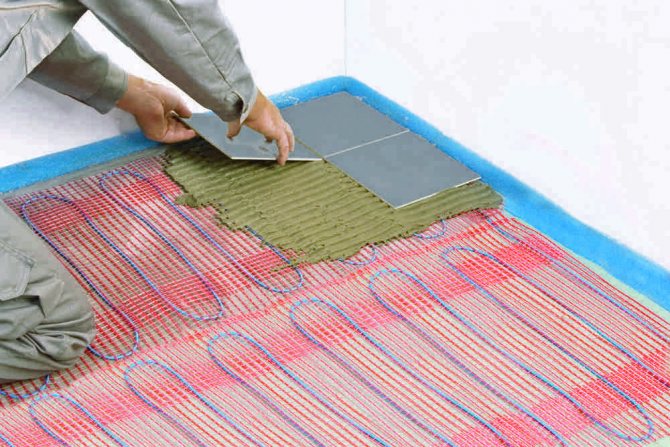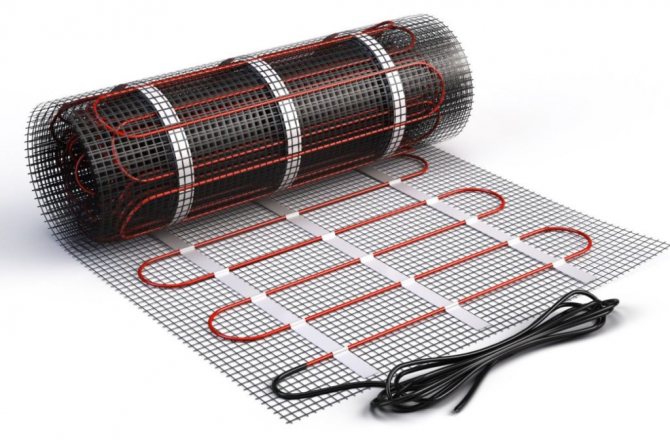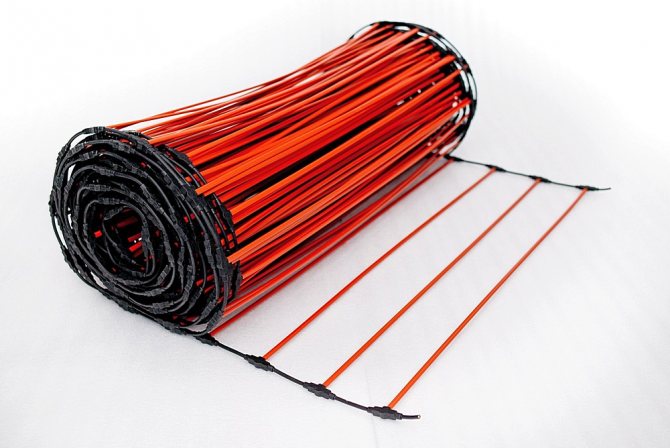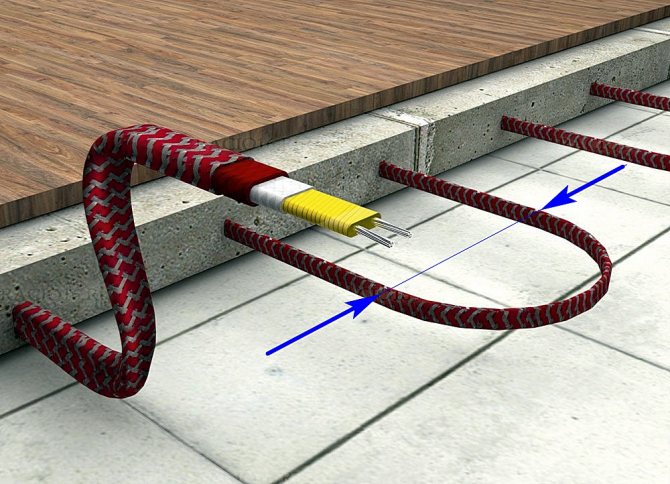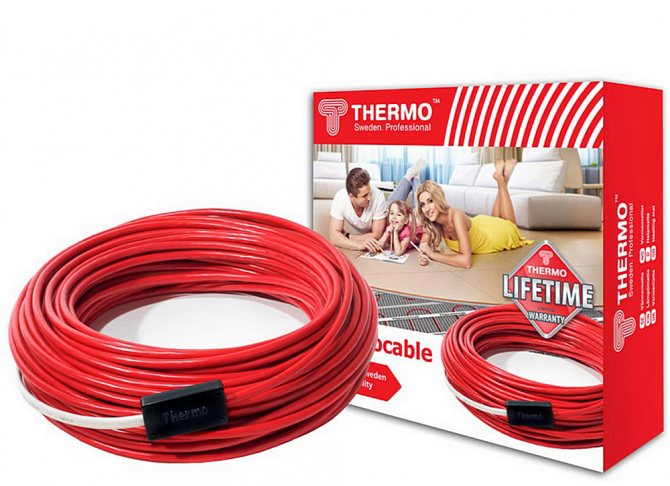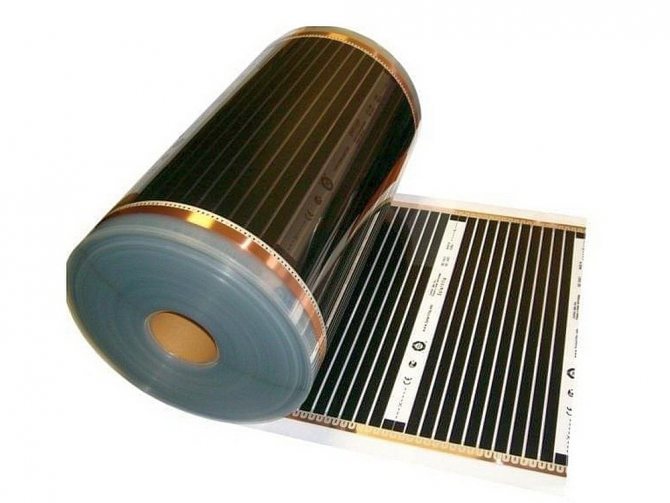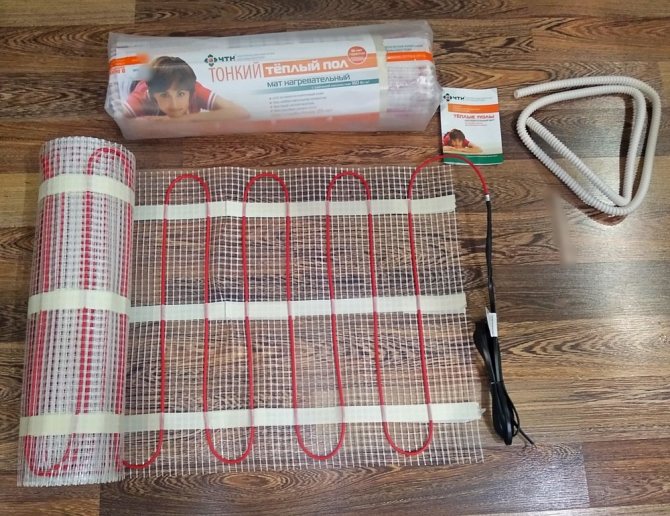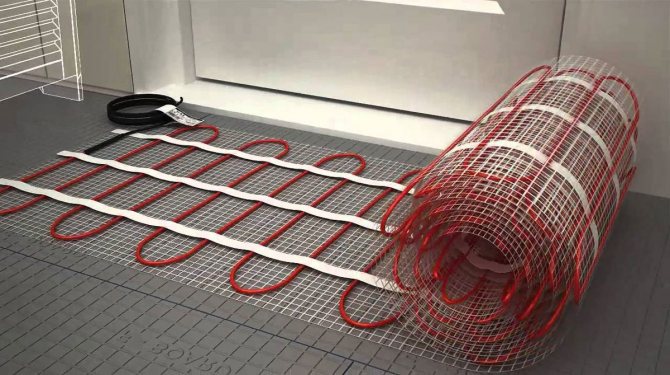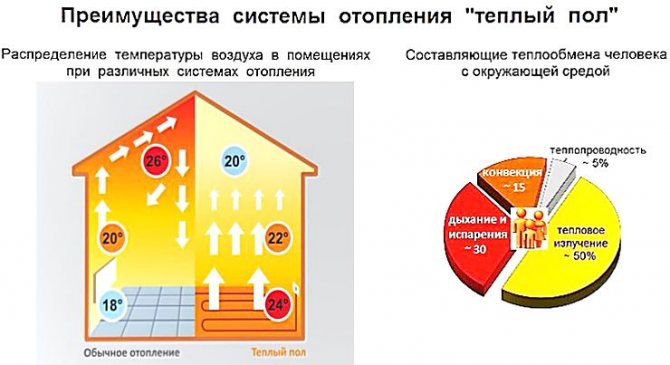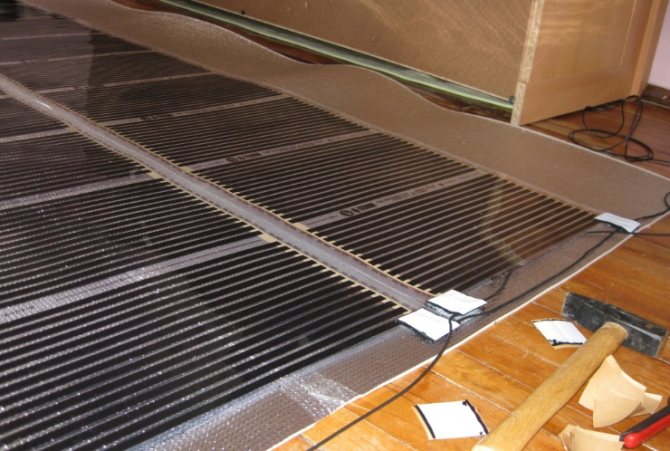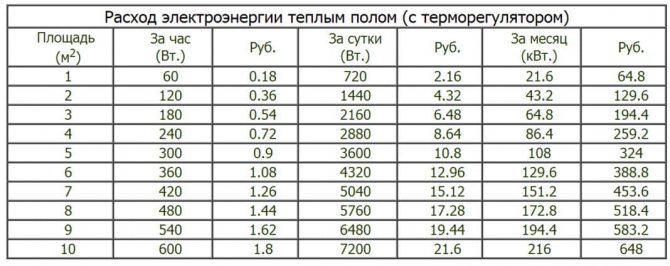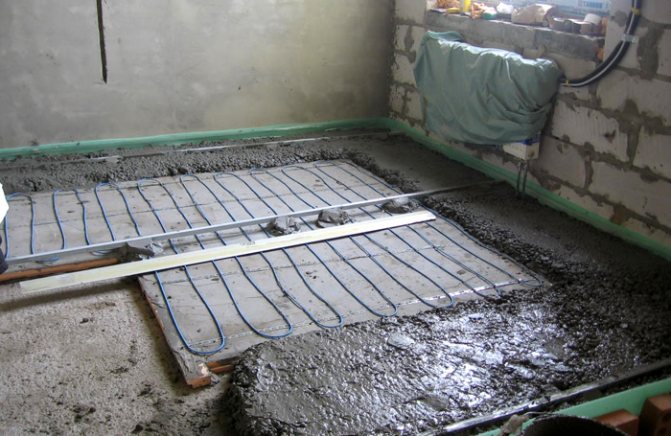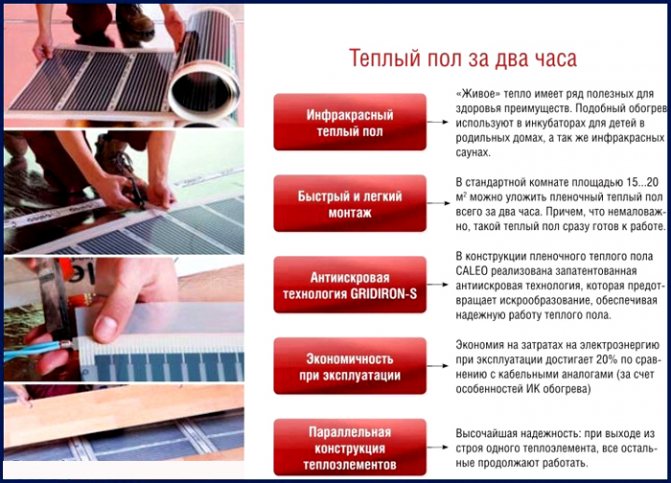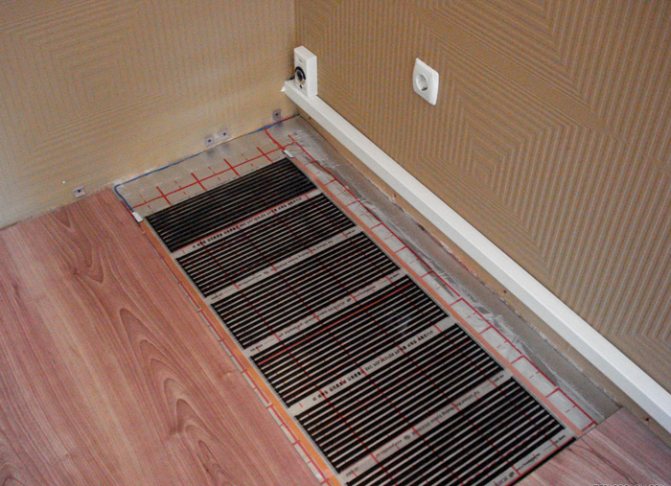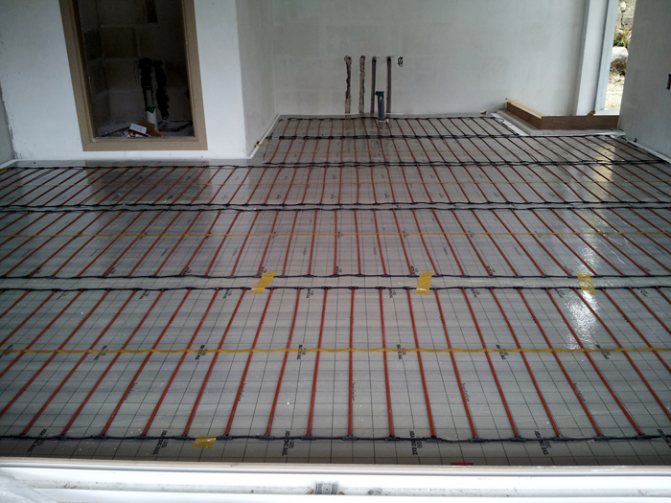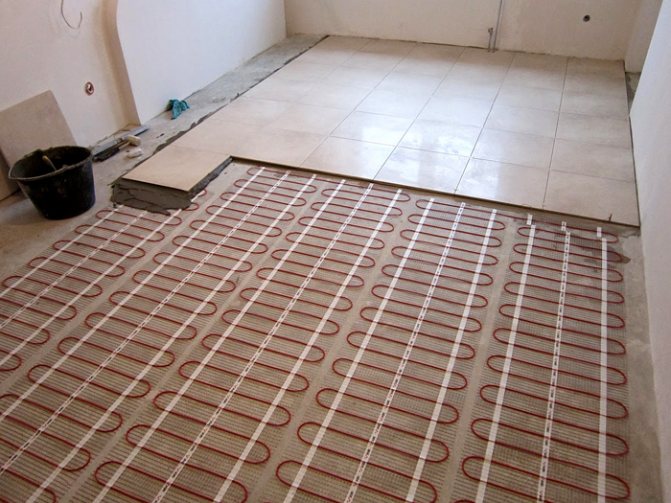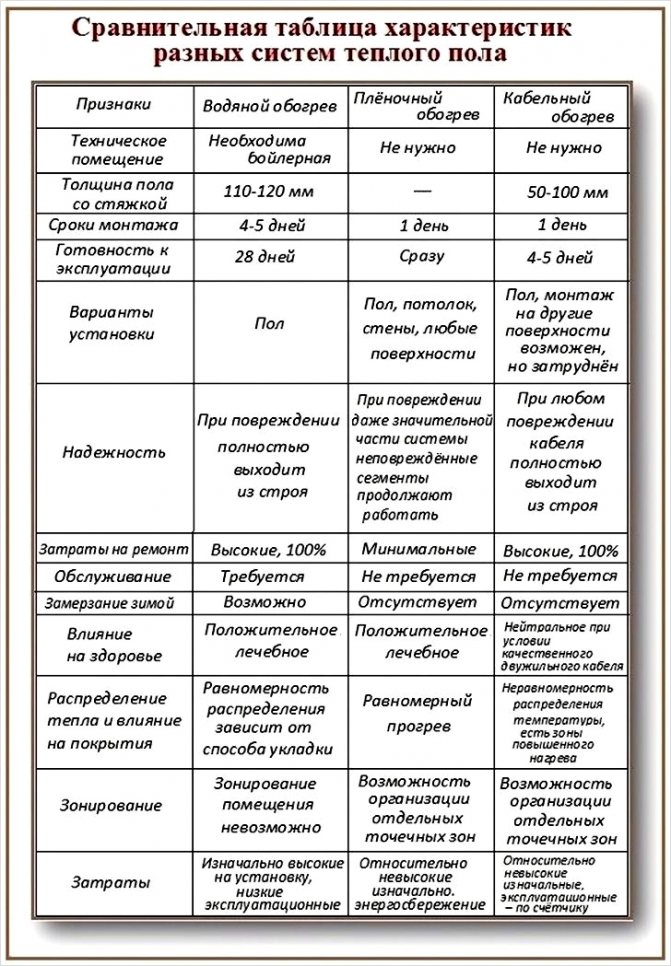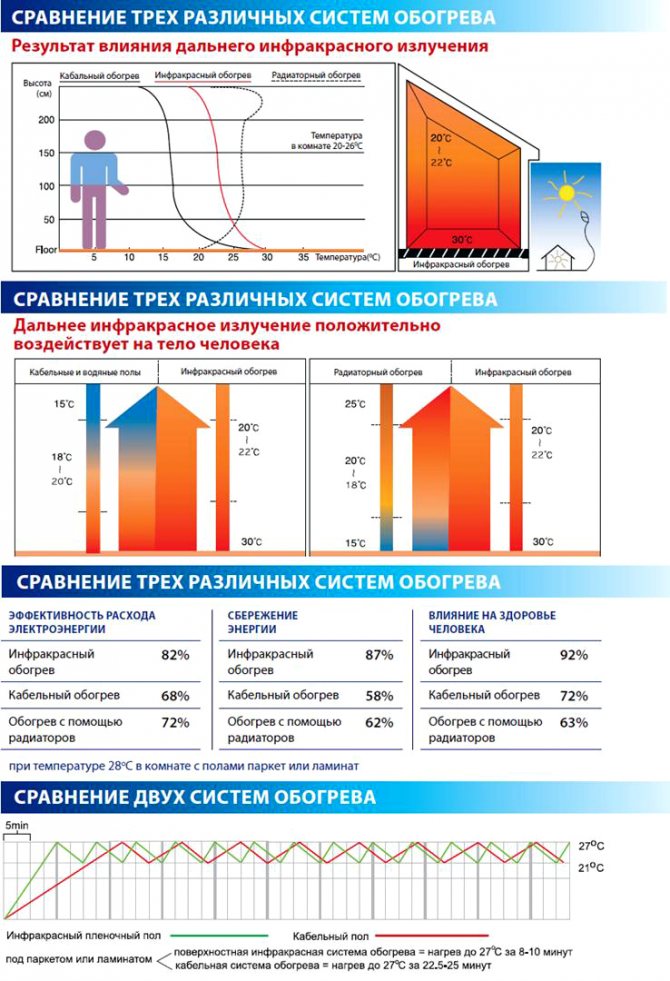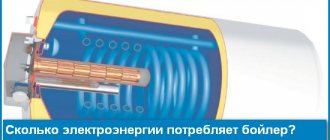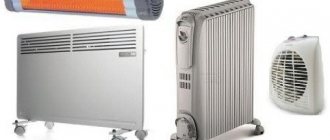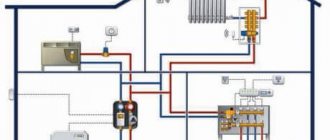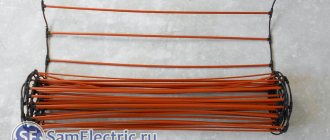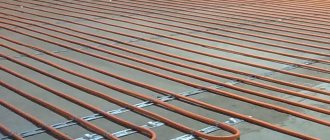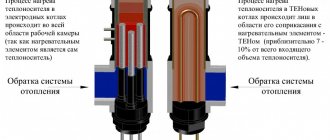Floor heating systems have already become part of the life of a modern person. Indeed, homeowners are given the opportunity to make their stay in the premises as comfortable as possible, to ensure the optimal gradation of air temperature in height, to forget about their feet chilly on the cold floor coverings. Well, if there are young children in the family, then a timely tidied floor becomes an ideal and completely safe playground, without the need for flooring rugs or rugs that are always collecting a bunch of dust.
How much does an electric underfloor heating consume?
Among the varieties of underfloor heating, water systems show great efficiency in operation. But they are extremely difficult and expensive to create and debug, require extremely large-scale preparatory and installation work. And in many cases, especially when it comes to city apartments, it is completely impossible in principle.
But the electric "warm floor" for many owners is quite a feasible task. The cost of purchasing components is significantly less, instead of complex and cumbersome manifold and distribution units, a rather compact thermostat is used to control the system. But the operating costs frighten many, for a trivial reason - because of the high cost of electricity. Therefore, it is not surprising if, when assessing the prospects for creating such a system, the homeowner seriously thinks about the question of how much an electric floor heating consumes?
Let's try to figure it out.
Types of electric underfloor heating
Today on the market there is a huge range of electric type floor systems. All of them are divided into several types.
Below we will analyze in detail the technical characteristics of each type, calculate the electricity consumption depending on the type of premises per 1 m2 per hour, per month. We will also find out how the finish coating affects energy consumption.
Electrical cable
An electrical cable is a wire that can be laid arbitrarily, but more often according to the "snail" or "snake" scheme. From above, the structure is poured with a concrete screed, which reduces the height of the room by an average of 5 cm. The specific power of such a cable is from 0.01 to 0.06 kW / m2, its choice depends on the frequency of turns.
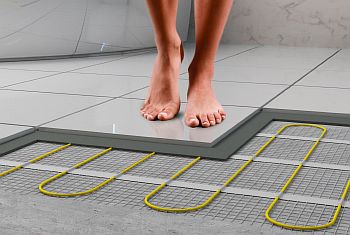
The power consumption of one meter of cable is from 10 to 60 watts. To cover 1 m2 of surface, about 5 meters of wire is required, thus for heating, on average, 120-200 watts of electricity is needed.
Thermomats
Heating mats are a construction of a cable that is laid according to a certain pattern on a special mesh. It is more often installed under the screed, and is perfect for laying in rooms with high humidity.
This model is intended for rooms with low ceilings, since the thickness of the "cake" is only 3 cm. The power of the mat is up to 0.2 kW / m2.
The average power consumption per square meter of the heating mat is 120 - 200 W.
Infrared film
Infrared underfloor heating - a thin polymer film with an applied carbon layer. When heated, carbon emits heat.
IR foil does not affect ceiling heights. On average, about 150 - 400 W of electricity is wound to warm up 1 m2 of film.
Rod floor
Rod floor - refers to the infrared type, only contains rods instead of carbon plates. Its power consumption is 120 - 200 W per square meter.
What power should a warm floor have, and how is it achieved
It must be that some readers, having learned about the variety of electric floor heating systems, are now waiting for revelations, which of them consumes the least energy?
Do not wait!
And not at all because the author is secretive and greedy, does not want to confess and share secrets. And simply because none of the systems in this matter has any advantages. No matter how they assure you of the opposite!
Expert opinion: E.V. Afanasyev
Chief editor of the Stroyday.ru project. Engineer.
This means that if, according to calculations, you need to apply 120 watts per square meter of room area, then it does not really matter which of the heating systems will produce them. All the same, about 120 watts of electrical energy will be spent on this, since the efficiency of electric heating systems is always very close to 100%.
Another thing is the speed of the system reaching the calculated heating of the floor surface. So, after turning on the foil heater, an increase in the surface temperature of the topcoat (for example, laminate) is felt after a few minutes. But a cable or a mat, enclosed in a screed or a layer of tile glue, will take more time - you have to first heat up a rather thick and very heat-absorbing mineral layer, or even "cold" ceramic tiles. But on the other hand, such inertia will be a plus when the heater is temporarily turned off - the heat accumulated by such a "battery" will be given to the room for a longer time.
But in general, if we calculate according to the results of work, for example, during the day, the total energy consumption in different systems, but of equal thermal power and in equal conditions, will reach the same level. If, of course, the system is debugged and equipped with a high-quality thermostat.
But what should be the power of floor heating?
And it depends on what role is assigned to the "warm floor" system.
- BUT. If it is created as a complete alternative to the traditional heating system, then the calculation should be based on the amount of required heat power to compensate for heat losses in the room. All this replenishment must completely "rest on the shoulders" of the heating system.
This value is often taken equal to 100 W per 1 square meter. But one can argue with this, since such a calculation is imperfect. You'd better come to the matter more thoroughly.
How to determine the amount of heat energy to fully heat a room?
To do this, you can use a rather detailed calculation algorithm, which takes into account many factors affecting the final result. This algorithm is well laid out and implemented in the online calculator in the publication "How much heat is required to heat the house".
Expert opinion: E.V. Afanasyev
Chief editor of the Stroyday.ru project. Engineer.
It turns out that this amount of heat needs to be divided by the area of the room - you get the specific heat per square meter, right?
Not certainly in that way! With electric underfloor heating, the entire area of the room is never used, even if we are talking about a complete alternative to traditional heating. There is no point in laying heating elements (no matter what) under stationary pieces of furniture or large household appliances. This is both useless and very harmful to furniture, flooring and the heater itself - due to the lack of proper heat dissipation. Necessarily indents are made from the walls and from the existing heating devices. As a result, the area on which the heaters can be located decreases by 25-30%.
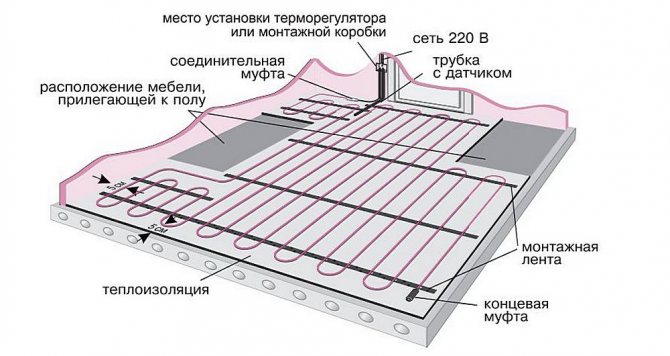

An example of a heating cable layout in a room - far from the entire area is involved.
This means that the total thermal power will have to be divided by this, so to speak, "useful" area allotted for laying the heaters. This ratio will show the required specific power of the system, W / m².
In a simplified version, when there is no desire to get involved with the calculation of heat losses, the specific power is taken to be approximately equal to 180 W / m². If the "warm floor" is installed on a floor above a heated room, then the power can be reduced to 150 W / m².
Let's repeat - this is very approximate, and we cannot vouch for a guaranteed successful outcome with such a choice of power.
And by and large, an electric underfloor heating should not at all be considered as a full-fledged alternative to heating. It's too wasteful pleasure. If, when using an electric boiler, you can use the preferential night rate with might and main, accumulating the heat generated during the night in a heat accumulator (buffer tank) and gradually spending it then during the day, then this will not work with a warm floor.
Therefore, you need to think ten times before making such a decision.
- B. It is a different matter when electric floor heating becomes a means of increasing the comfort of living. That is, the heating works by itself, but in the rooms it is possible to create “areas of special comfort” with warm floor surfaces.
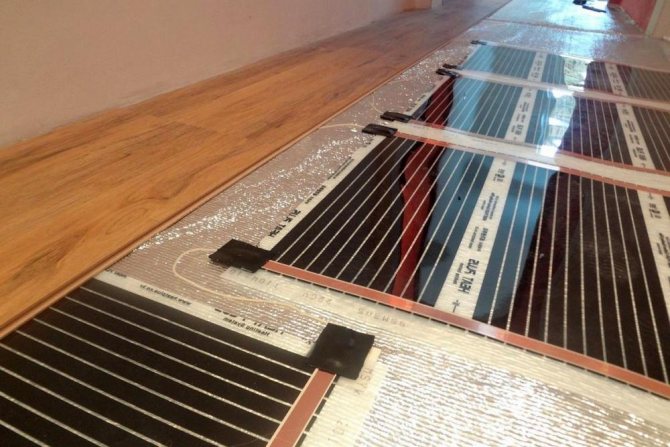

Very often, there is no point in covering the surface with heating elements - they are placed only where it is really desirable to have a heated floor surface.
This is usually done in places where children play, in recreation areas or in the work of apartment owners - in a word, where it is pleasant for them to feel the warmth coming from below to their barefoot feet or feet shod in light slippers. For example, it makes sense to place such areas near the bed (in the morning it will be more pleasant to put your feet on the heated floor), along the sofa, under the desk, along the traditional "paths" from room to room, in the kitchen, in the bathroom and (or) bathroom, etc. P.
Here you can not only reduce the area of the "warm floor" to the required minimum, but also be guided by completely different indicators of thermal power. Usually 120 ÷ 130 W / m² is quite enough, and if the room is located above a heated room, then sometimes even 90 ÷ 100 watts can be limited.
* * * * * * *
Below is an online calculator that implements a lot of the above. This application will help you calculate several basic values for an electric "floor heating":
- For any heating system - specific power (W / m²) and total, total power of the "warm floor"
- For a cable system, that is, with the possibility of varying the density of the heater packing - the length of the cable and the step of its laying. To do this, you will have to additionally indicate the specific linear power of the selected cable.
By the way, one more nuance. At the same time, you can select the optimal linear power density and the paving pitch. The fact is that it is not recommended to place the turns of the cable too close or too far from each other. In the first case, it is possible to create overheating zones, which is harmful to both the floor and the cable. And in the second, a "zebra effect" may appear, that is, the alternation of hot and cold stripes felt by the foot. The optimal step is from 80 ÷ 100 to 200 mm. Perhaps it makes sense to slightly change the linear power of the cable (from the assortment available in the store) in order to reach the optimal indicator.
Calculator for calculating the main parameters of an electric floor heating
Go to calculations
Calculation of electricity costs by type
To determine how much an electric underfloor heating consumes current, consider a number of the following factors: heat loss, base thickness and the degree of thermal insulation of the room.
The formula will help you calculate the amount of electricity consumed:
W = S * P * 0.4, where
- S - area in m2;
- P - power;
- 0.4 is the coefficient of the heated useful area.
Electric cable and mats
To determine the amount of electricity consumed and the cost of paying for it during the operation of the cable system, it is necessary to take into account a number of points:
- The size of the heated area is a free part of the room without furniture. Usually it is 12 - 15 sq.m., this is where the cable or mats will be laid.
- To heat 15 m² of floor, on average, a wire is required with a total power of 2100 W / h. More often, consumers purchase foreign products designed for a voltage of 230W. In our conditions, such a cable cannot function at full strength. It is capable of consuming no more than 1930 watts.
- 1930 W is the power consumed by a warm cable floor at maximum load. In this case, the heating temperature can reach + 45 ° C. A comfortable temperature is considered to be up to + 23 ° С. A floor in such conditions can consume about 965 watts.
- According to calculations, to maintain a comfortable atmosphere, it is necessary to heat the cable for 20 minutes every hour. As a result, the power consumption for heating 1 m2 of floor is no more than 322 W / h.
It is possible to pay less for the energy consumed by a cable warm electric breaker if you use a two-tariff meter.
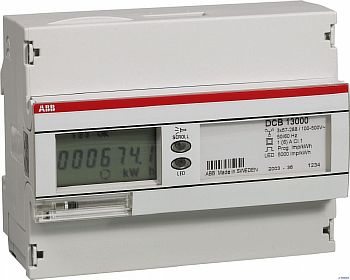

In addition, when using a cable, to determine the amount of electricity consumed, you need to calculate its length. This can be easily done using the formula:
L = l / a
Where:
- l - wire length:
- a - the step between the cable loops.
Multiplying this value by the power of the wire (120-200 watts), you get the amount of electricity consumed by a heated floor per 1 m2.
Infrared floor heating
If infrared warm floors are used, then the degree of preparation of the room affects their energy consumption, as in the functioning of any heating system. In addition, film power is considered an important factor. When using the device as main heating - 220 W / m2, if additional - 150 W / m2.
For your information! Film 220 W per hour needs to be warmed up for 5 - 7 minutes, and 150 W - 12 minutes. At the same time, they will consume electricity in the same way on average.
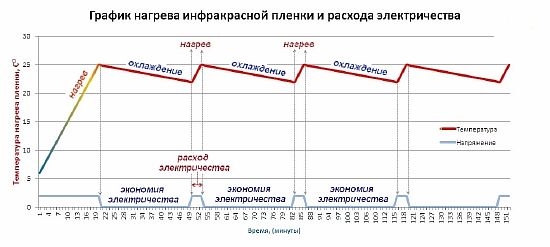

How much energy is consumed by warm film floors per month, let us consider the example of a room of 50 square meters, with a film power of 150 watts. For this:
W = 50 * 150 * 0.4 = 3000 W or 3 kilowatts in 60 minutes.
To calculate your monthly consumption, you need:
3000/60 minutes x 5 minutes (running time per hour) x 12 hours per day x 30 days per month = 90,000 W / month or 90 kW
The resulting indicator is multiplied by the tariff of your region - so much you will spend on paying for light in money. Naturally, this figure is approximate, and when using the counter "day - night".
With the correct calculation and planning, costs can be significantly reduced.
Infrared carbon rods
IR bar floor is the evolution of cable and film systems. It is made in the form of a mat, but instead of a two-core wire, carbon infrared rods are used here. They emit infrared radiation that heats the floor. They are also mounted under a screed or glue. The operating temperature is almost the same as that of the film, about 60 ° C, but the power consumption is noticeably reduced and averages 120 - 160 W / m2.
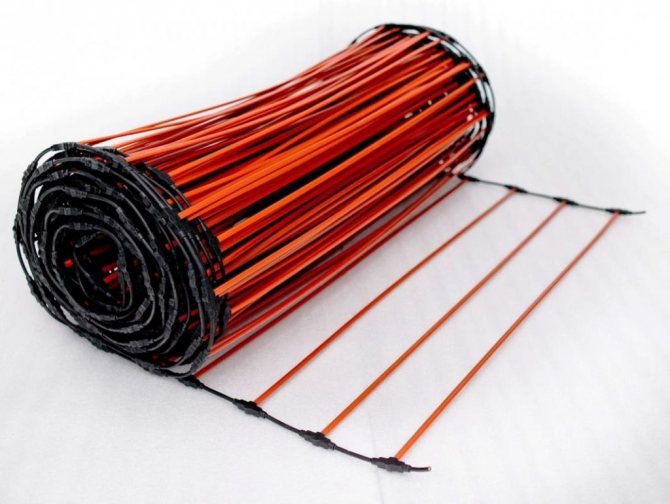

The core floor does not dry the air; you can safely put any furniture on it. Today it is the most expensive type of underfloor heating, and it is also used for the most part as an additional source of heating. For installation in a toilet, Unimat BOOST-0600 is suitable, which, with the total power of the heating elements, is capable of high-quality heating up to 4.98 m2 of usable area.
Energy costs depending on the topcoat
When choosing a finishing material for laying on a warm electric floor, it is necessary to have a pictogram on the product, which indicates the possibility of being adjacent to a heating device. Most often, floor heating systems are laid with ceramic tiles, linoleum or parquet.
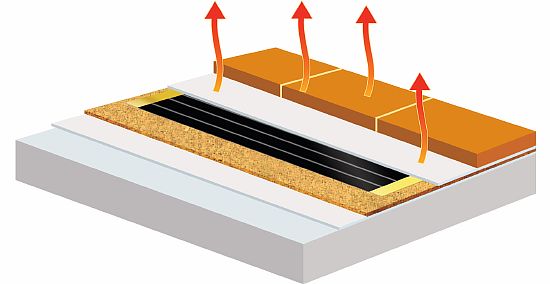

It is worth noting that the level of electricity consumption of 1 sq m of a warm electric floor is also affected by the finish, or rather its thermal conductivity.When choosing a laminate or board, your heating costs will rise, as they have a low degree of thermal conductivity.
But ceramics, linoleum or carpet are an ideal and economically viable material. Surface heating is carried out quickly, and a minimum amount of resource is spent on this.
Heating parts power
The main types of electric floor are considered to be film, heat mat and heating wire. As for the film base, it must be used when installing the system under parquet and linoleum, mats and wires are used to heat the ceramic tile floor.
Each of the above heating elements has its own characteristics: power, thickness, heating temperature. Today we will find out how much energy the floor of each species consumes.
So, you have installed a warm floor, the energy consumption of the heating parts is as follows:
- Film coating - from 140 to 400 watts per m2.
- Heating cable - 10 to 60 watts per m2. Usually, about 5 turns of material are installed per m2 of surface, so that the total power is 121-160 watts per m2.
- Heat mat - from 119 to 199 watts per m2.
As you can see, the performance of the electric floor is from 119 to 199 watts per m2, which allows the system to be installed both for complete heating of the room, and for additional heating.


Calculation of energy costs by electric floors, depending on the type of premises
There are certain standards according to which a device of its own power is recommended for each room:
- in living rooms, kitchen and corridor - up to 120 W per m2;
- in the bathroom - 150 W / m2;
- in the loggia - 200 W / m2.
In addition, the power of the system is influenced by its purpose - it will be the main or additional heating.
For example, if a warm floor is the main source of heat in a room with an area of 20 m2, with a usable area of 8 m2, then the heat loss will be equal to 2 kW / h. Based on these data, the power is calculated:
- heat loss / area = 2/8 = 0.25 kW / m2
If you live in a region with a harsh climate, add 25%.
Cable systems
The heating element here is a high-resistance conductor. Due to the high resistance, the core begins to warm up and give off heat to the floor. The most widespread is a two-core cable, the cores of which are connected at one end. The cable has external insulation and a metal braid (shield).
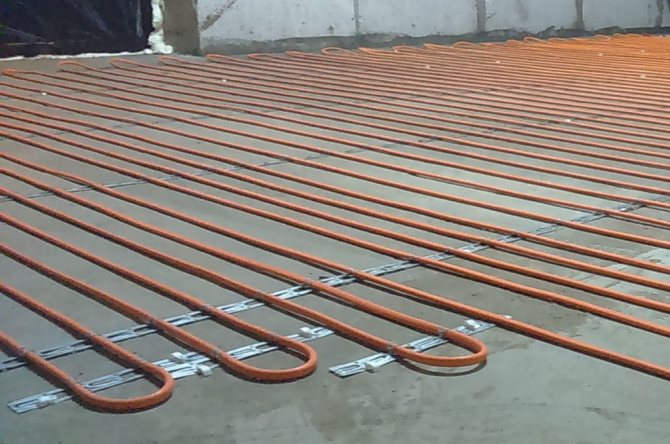

Installation is carried out using a metal tape with a zigzag conductor laying. Electricity and heating consumption largely depends on the step of laying the cable. On average, the power of a two-core cable is 110 - 150 W / m2, and an average of 7 running meters of cable are laid in 1 m2 of area.
The undoubted advantage of cable systems is their low price in comparison with other types of underfloor heating. So, for example, the Caleo Cable 18W-60, costing 5800 rubles, is able to heat 8.3 m2 (the average size of the bathroom), while you will have to pay 30% more for the heating mat.
Comparative analysis of the consumption of warm floors by type
In all electric floors, induction heating of the surface is carried out, that is, using an electric current. Conversion of electricity into thermal energy takes place with approximately the same efficiency. The size of the energy consumption of the warm floor is influenced by the installation method and the floor covering.
The following factors are of great importance:
- Thermal insulation and reflectivity of the underlying material;
- The degree of heat loss in the screed is important for screed structures.
After analyzing the above, we can summarize that:
- the most energy efficient heating devices are placed directly under the decorative item;
- laying high-quality insulation with a reflective surface and isolating the edges of the screed from the walls, will reduce the differences between models in terms of cost-effectiveness.
Despite the slight discrepancy in the level of electricity consumption of different types of electric floors, there are still differences. The most significant consumption for the film is 220 W / m2, the degree of maximum heating is +40 degrees.
When installing the cable in a screed - 150 W / m2. Therefore, if the design allows it, it is more economical to lay the cable system in a tie. With well-made thermal insulation, the device will warm up the screed for about 8 hours, and then it will give it to the room.
However, this difference in the consumption of electric current by different types of systems is not significant, when they are laid in rooms of a small area. The costs of installing them throughout the apartment differ significantly.
Ways to Reduce Energy Consumption of Underfloor Heating


There are several ways to reduce the electrical consumption of your underfloor heating system. The use of high-quality thermal insulation materials in the room, as well as the use of flooring that conducts heat well, such as tiles, helps to reduce energy costs. These manipulations can reduce consumption by a third.
The tiles can be laid on any kind of warm floor. It has good thermal conductivity, due to which floor heating is carried out due to the consumption of less electricity.
The surface of the floor and the tiles from the back are treated with glue, after which it is placed on the floor in compliance with the geometry. After the glue has dried, grout is carried out. Sometimes some craftsmen put a layer of primer under the tiles, but this is not required when working with high-quality glue.
But the most effective way to minimize costs is to install a thermostat.
Thermostats
A thermostat is a special device that turns on floor heating when the room temperature drops to a certain value. The required temperature is set by a person, when the set temperature is reached, the floor turns off, and after cooling it turns on again. This principle of operation allows you to reduce electricity consumption by 40%. The device receives data on the temperature regime in the room using a temperature sensor, which should be installed in the coldest place in the room.
There are the following types of thermostats:
- Mechanical. The simplest and least expensive thermostats. They work completely autonomously;
- Electronic. Has a dedicated display showing all settings. The electronic thermostat receives data on the temperature in the apartment using an external or internal temperature sensor, based on the information received, the thermostat adjusts the heating operation time;
- Programmable. A subspecies of electronic thermostats. Allows you to fine-tune the operation of the thermostat, having a large number of settings and functions;
- Sensory. The most perfect view, allow you to fine-tune the operation of the thermostat using the touch screen.
Factors that reduce energy consumption
As already mentioned, when installing electric underfloor heating in all rooms of the apartment, the cost of payment will be impressive, which will affect your family budget.
However, there are ways to reduce energy consumption:
- Carrying out high-quality insulation - good thermal insulation reduces consumption by 35 - 40%.
- Installation of a multifunctional meter - the cost of electricity used at night is about 2 times lower. Moreover, the heating mainly works when there are people in the house, and this is usually evening and night.
- Install underfloor heating on a free area. Laying it under furniture is not only unprofitable, but also prohibited by the system manufacturer.
- Use of finishing coatings with good thermal conductivity.
- Installing a programmable thermostat - especially in residential premises, will save a third of energy costs.
- In rarely inhabited rooms, not maintaining a high degree of heating is an unnecessary winding of energy.
In addition, if you reduce the degree of heating by only 1 degree, then this will not affect the atmosphere in the room much, but the savings will be 5%.
Climatic conditions are also of great importance. The greater the difference between the temperature in the room and outside the window, the higher the power consumption of electricity increases.
Thermostat is an indispensable device for reducing costs
Separately, it should be said about the thermostat - its use can reduce power consumption by up to 40%. It is recommended to install the device in the coldest part of the room. When the temperature drops below the set value, it will turn on the heating, and when the desired value is reached, turn it off.
For your information! Most of the regulators are designed for a voltage of 10 amperes, such a device can withstand a load of no more than 2300 watts.
In many ways, the type of thermostat affects the consumption of electricity, they are:
- mechanical - the design is simple and inexpensive, the daily working time is about 12 hours;
- programmable - equipped with several modes that allow you to control the work, such a device operates only 6 hours a day.
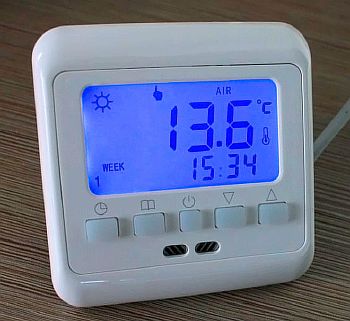

For example, consider what type of thermostat will be more economical. To do this, we will use the formula:
Рд = t * Ptot;
t is the operating time of the device;
Ptot - power.
When installing a 900 W mat and using a mechanical type regulator:
Pd = t * Ptot = 12 h * 900 W = 10 800 W = 10.8 kW
If a program controller is installed, then:
Pd = t * Ptot = 6 h * 900 W = 5 400 W = 5.4 kW
From this calculation it can be seen that the use of a programmed regulator will significantly reduce your costs.
If the warm floor acts as the main heating in all rooms, then it will be necessary to install several regulators that are connected to one centralized system.
Thinking about installing an electric floor in a house or apartment, you should carry out all the required calculations, taking into account the maximum load in winter. Only after weighing all the pros and cons, you need to decide on the installation of such a design.
And how much will an electric floor heating consume
Now we are almost ready to answer the main question of this publication.
It would seem - which is easier? It remains only to multiply the power of the system by the duration of its operation - and get the number of kilowatt-hours, as they say, “payable”. However, if we follow this path, then for sure in a very "serious" amount.
In fact, electric floor heating, if it is organized in a room with effective thermal insulation (otherwise it should not be, categorically!), Will never work all the time. It's all about the thermostatic control of the system.
Expert opinion: E.V. Afanasyev
Chief editor of the Stroyday.ru project. Engineer.
Heaters are never directly connected to the power supply - only through a thermostat. It is an electromechanical or electronic device that devalues a power off if the temperature at the sensor reaches a certain upper limit. And, accordingly, inclusions if the temperature drop reaches the lower limit. Something similar is in any modern iron. Temperature sensors are most often used remotely, laid in the floor along with heaters, or built-in, which record the air temperature in the room. Such sensors "by air" are usually used in those "warm floors" that become a complete replacement for the heating system (not recommended!)
It must be understood correctly - such control units do not work to change the input electrical parameters, that is, they do not transform either the current or the voltage supplied to the heating elements in any way. The decisive factor here is exclusively the doffing time - on or off.
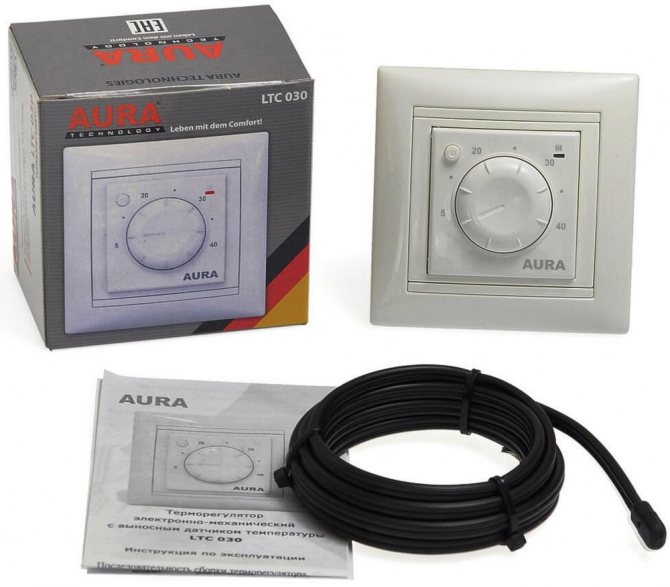

One of the simpler thermostats with the included temperature sensor
Look at the installation diagram above - it is not for nothing that a temperature sensor is installed between the cable turns (between adjacent heating elements) - it is he who removes the floor heating temperature and transmits it to the control unit. That is, after turning on the system, the floor begins to heat up and is brought to a predetermined threshold: usually it is 26 ÷ 27 ℃ - higher does not make sense, since the feeling of comfort can become controversial, it starts to "bake", and it is not useful for covering the floor. Having received a signal that the desired temperature has been reached, the thermostat turns off the power to the heating element. The temperature has dropped - the power is turned on again.
Practice shows that a well-functioning system in an effectively insulated room works no more than 50% of the total time, fully coping with its task. This, of course, is an average figure, since on especially warm days it can be much less, or, conversely, in frosty weather - and more. But in general, this is how it can be predicted.
But that's not all.
If an electric "warm floor" is equipped according to the principle that is most preferable for it, that is, it will work in parallel with the heating system and only create "comfort zones", then its operation can be optimized by installing an electronic programmable thermostat.
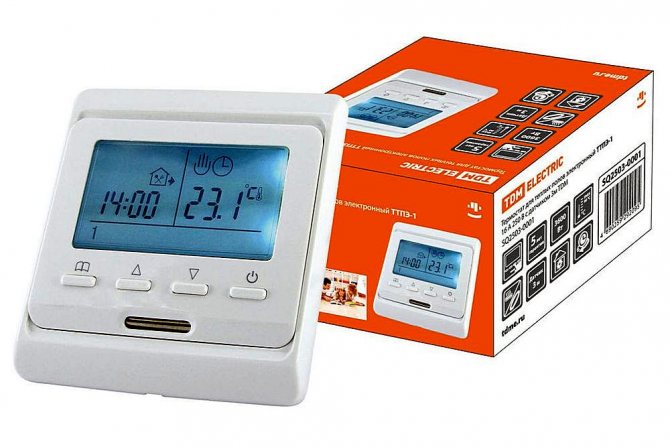

The cost of such a thermostat is somewhat higher, but this is fully justified by the subsequent energy saving effect.
Think for yourself - is it worth "driving" such a system day and night? Who needs comfortable heating at night or when the owners are away? Wouldn't it be better to program the operation of the "warm floor" so that it turns on only when it is really required.
For example, half an hour before getting up - to warm up the area near the beds in the bedroom and nursery, floors in the bathroom and in the kitchen. Then, when everything scatters to schools-works, there is a general pause. By the time the child arrives from school, you can warm up the floor in the nursery. For the return of adults - in other rooms. And so on - there can be many options here. On weekends, the system can be programmed in a slightly different way - everything is in the hands of the owners.
Expert opinion: E.V. Afanasyev
Chief editor of the Stroyday.ru project. Engineer.
The savings are more than sensitive! Moreover, the principle of thermostatic control continues to work, that is, heating is not carried out constantly.
More precisely, the heating temperature is also programmed for the "pause time", but it is comparable to the air temperature in the room, maybe a little lower. That is, the thermostat will not turn on the power until the floor temperature gets even lower. What should not happen when the general heating system is working - a real pause in the operation of the heaters is achieved.
Below is a calculator that will allow you to quickly "estimate" the approximate electricity consumption of an electric heated floor in a particular room.
You just need to indicate the total thermal power of the system and select the mode of its operation.
- With continuous operation, everything is clear - you can be sure that it will cost a lot.
- If a programmed algorithm is selected, then one night pause in work can be foreseen for weekdays and two more - during the day. On weekends, you can limit yourself to only a night one, but it is possible to add one day break.
Calculator for calculating the energy consumption of an electric underfloor heating
Go to calculations
* * * * * * *
It may still seem a bit too much. But the reserves of savings are always in the hands of the owners! Again, here is a very rough calculation that does not take into account many conditions. But in reality, as practice shows, even a decrease in the heating temperature by only 1 degree (say, from 26 to 25 ℃) can give another 5% savings.
In addition, it is advisable not to take the time to draw up a diagram - to think over how much heating is necessary on a particular area of the floor. Perhaps somewhere you can easily do without it.Or - to change the operating mode of the system in the direction of reducing the duration of the periods of its activation - the calculator clearly shows how this reduces the overall costs.
In conclusion - a video, in which its author offers his vision of the problem of electricity consumption for floor heating. Interesting, but one can argue about something.
System power selection
It is worth noting that the power consumption of a warm electric floor, and, accordingly, the consumption of electricity, the heat transfer of the system are the main criteria when choosing a warm electric floor. If the capacity is in excess or, on the contrary, it is not enough, the installation will become ineffective.
The required power of the underfloor heating directly depends on whether the system will be used as the main or additional source of heating.
In the first option, the power consumption per square meter of electric floor heating is 150 watts, in the second - 110 watts. Floors with a capacity of 150 watts are most in demand among domestic users. Of course, there are also installations with a higher power level.
Also, the specific power of a warm electric floor depends on the type of room. For example, for a bedroom it is 110-150 watts, for a glazed balcony - 140-180 watts, for a bathroom - 140-150 watts. When calculating power, it is important to take into account the number of storeys in the room. If the apartment is located on the first or second floor, add 20% to the given values.
The calculation of the power of a warm electric floor is very simple: it is necessary to multiply the floor area by the specific power. Each separate room has its own circuit with a thermostat. Since the temperature conditions are different in different rooms, the setting of the thermostat will also differ. This means that the energy consumption for underfloor heating in terms of meters in different rooms will be different.
Factors Affecting Electricity Consumption of Underfloor Heating
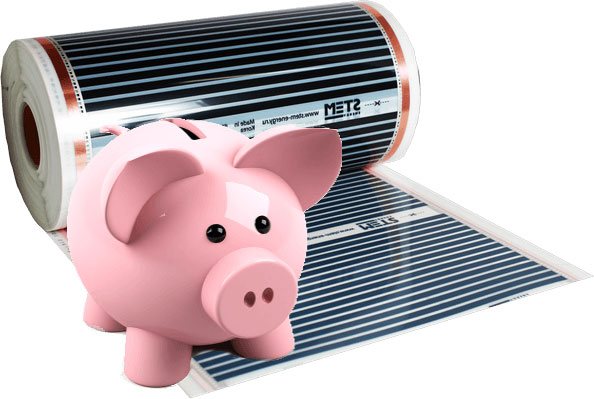

With proper installation and calculation, you can heat the house with high quality and not overpay
Electricity is an expensive source of energy, but efficient. If you choose the right heating system, you can provide the house with heat and not spend a lot of money on paying bills.
System type
There are several types of electric floor heaters:
- Heating cable - resistive or zone. The cheapest option. Accumulates some heat, after switching off the floor cools down slowly. The installation scheme is complex: the cable can only be placed in open areas, otherwise it overheats and breaks down. This modification is installed on balconies, loggias, in baths, where heating is required less often.
- Thermomats - convection and infrared. More economical and consume less electricity. Installation requires high qualifications. The thermomats are placed under a thin floor covering, placed in a screed or in a layer of tile glue.
- IR film - heating only by IR radiation. In this case, the stage of heat transfer to the coating disappears. IR films are more efficient. It is installed in residential premises where an acceptable temperature must be maintained constantly.
- Self-regulating - due to the inclusion of carbon-polymer material, the system self-regulates. In the cold section, the resistance of the cable drops, a current of greater intensity passes through it and heats it. When heated, the resistance of the cable increases and the current decreases. This option is designed for the industrial sector, is expensive to manufacture, but more efficient than other modifications.
Less energy consumption and cost are not the only factors in choosing a product. It is unprofitable to install cable heaters in rooms with low ceilings; more expensive IR films are installed here.
External factors
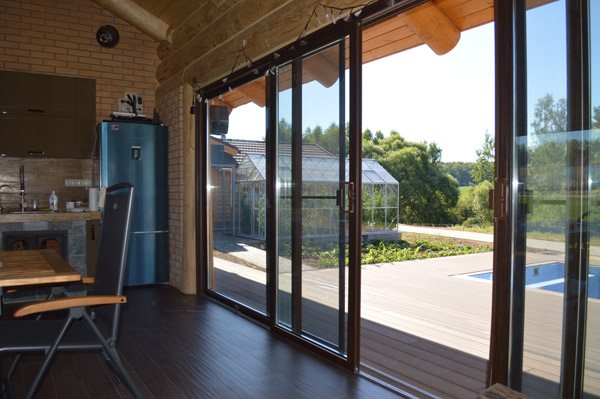

Electricity consumption is affected by the area of windows and doors, their number
Factors determine the amount of heat loss.The smaller they are, the less powerful heating can be installed, and the less you pay for electricity. Consider the following:
- Number of windows and doors - metal or glass surface conducts heat well. Prevent losses by insulating doors.
- The level of resistance to heat loss - the value is the indicator of the wall material - brick, concrete, quality, thickness of the heat-insulating layer, characteristics of external and internal finishing. Insufficient thermal insulation negates the benefits of underfloor heating and leads to unnecessary costs.
- Weather conditions - in extreme cold, consumption naturally increases.
- The number of tenants - the more people live in an apartment, the less the heated floor works.
The infrared foil or heating cable can be installed not only on the floor, but also on the walls in a brick building, frame or wooden.
Floor characteristics
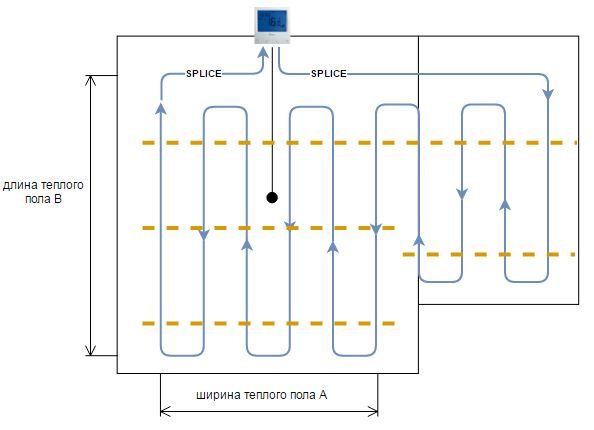

The wider the laying pitch, the less energy consumption
The energy consumption of any floor heating option is influenced by its own indicators:
- the presence of a thermostat - the more precisely the temperature is regulated, the more economical the system;
- cable laying step - the smaller it is, the more powerful the heater, the more energy it consumes;
- the thickness of the floor covering - laminate, tile, or screed - the smaller it is, the lower the electricity consumption.
Carpet or carpet reduces the efficiency of the floor heater and makes it work too hard. The material makes it difficult to dissipate heat, which can lead to overheating and damage to the cable. Only small decorative rugs are allowed.
How to reduce energy costs?
Since electricity costs a lot, many are interested in whether it is possible to somehow reduce the power consumption of a warm floor. A good alternative is to replace the electric underfloor heating with a water one.
The water-type system is much cheaper to operate. True, it has some nuances. For example, there is a risk of flooding if the integrity of the pipes is broken.
The installation of thermostats can also help save money. The system will only turn on when the room temperature drops to a certain level set by the user. And heating the room to the optimum temperature will turn off again for a while. As a result, electricity costs are reduced by up to 80%.


